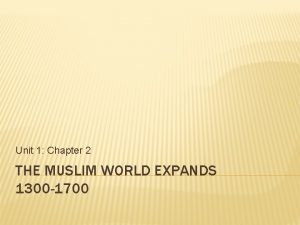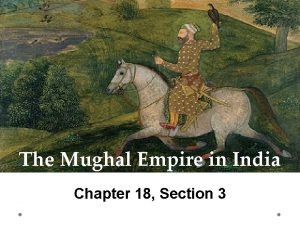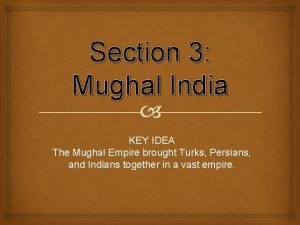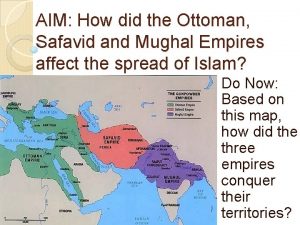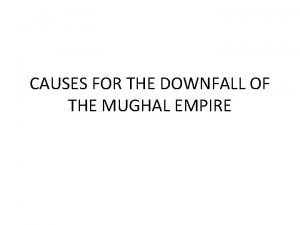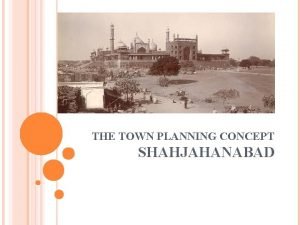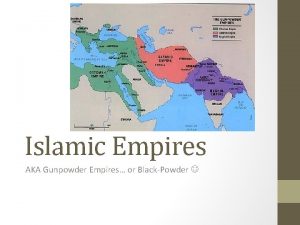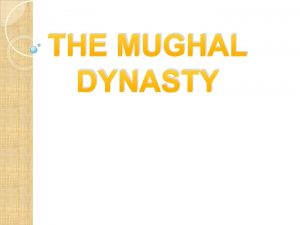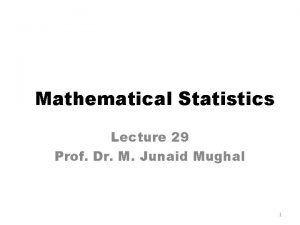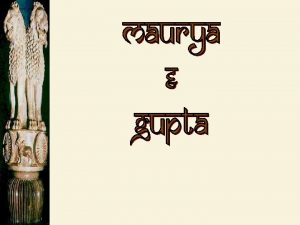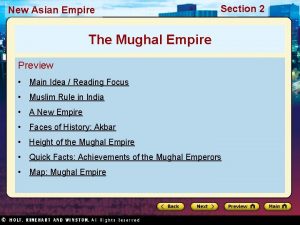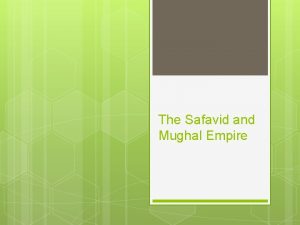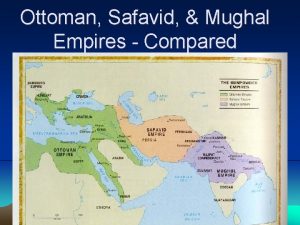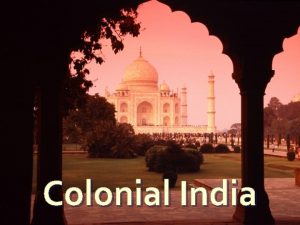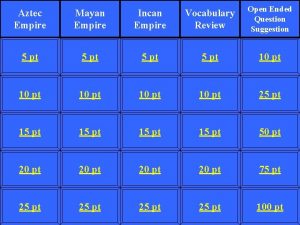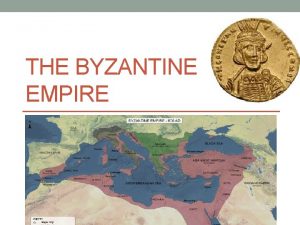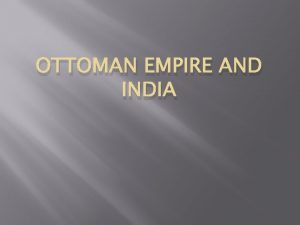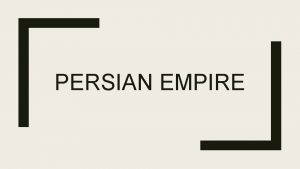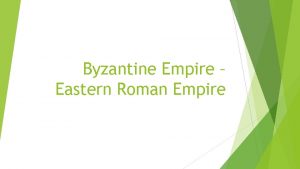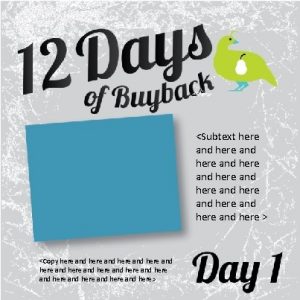MUGHAL EMPIRE When you here the term Mughalalso




























- Slides: 28

MUGHAL EMPIRE � When you here the term Mughal(also known as Mogul) what comes to mind? � Answers Vary(Mongols) � What has long been the dominate religion of India? � Hinduism


OBJECTIVE � WWBAT: Introduce the origins of the Mughal Empire and major leaders of the Mughal Empire � WWBAT: Complete a group simulation on the trade of the Indian Ocean and profit making in import/export trade

THEME TUESDAY BELLWORK � What is an example of Creation, Expansion and Interaction of Economic Systems in the Safavid Empire? � Answers Vary � What is an example of Development and Interaction of Cultures in the Ottoman Empire? � Answers Vary

OBJECTIVE � WWBAT: Introduce the origins of the Mughal Empire and major leaders of the Mughal Empire

� 2/14/2017 �Mughal Empire and Leaders �This will be one page

Mughal Empire Babur Aurangzeb Akbar

� There had been Muslims in India long before the Mughals � The first Muslims arrived in the 8 th century � In the first half of the 10 th century, a Muslim ruler of Afghanistan invaded the Punjab eleven times, without much political success, but taking away a great deal of loot � A more successful invasion came at the end of the 12 th century � This eventually led to the formation of the Delhi Sultanate � A later Muslim invasion in 1398 devastated the city of Delhi

�The Mughal Empire grew out of descendants of the Mongol Empire who were living in Turkestan in the 15 th century �They had become Muslims and assimilated the culture of the Middle East, while keeping elements of their Far Eastern roots �They also retained the great military skill and cunning of their Mongol ancestors, and were among the first Western military leaders to use guns

� The Mughal (or Mogul) Empire ruled most of India and Pakistan in the 16 th and 17 th centuries � It consolidated Islam in South Asia, and spread Muslim (and particularly Persian) arts and culture as well as the faith � The Mughals were Muslims who ruled a country with a large Hindu majority � However, for much of their empire they allowed Hindus to reach senior government or military positions

� Babur the first Mughal Emperor �was a descendent of Genghis Khan and Tamerlane � Babur succeeded his father as ruler of the state of Farghana in Turkestan when he was only 12, although he was swiftly deposed by older relatives � Babur moved into Afghanistan in 1504 � Then moved on to India, apparently at the invitation of some Indian princes who wanted to dispose of their ruler

�Babur disposed of the ruler, and decided to take over himself �He captured the Turkic Ghur'iat Sultanate of Delhi in 1526, imposing his rule on most of Northern India �The Empire he founded was a sophisticated civilization based on religious toleration �It was a mixture of Persian, Mongol and Indian culture �Under Babur, Hinduism was tolerated and new Hindu temples were built with his permission

� The third Emperor, Abu Akbar, is regarded as one of the great rulers of all time, regardless of country � Akbar succeeded to the throne at 13, and started to recapture the remaining territory lost from Babur's empire � By the time of his death in 1605 he ruled over most of north, central, and western India

� Akbar worked hard to win over the hearts and minds of the Hindu leaders � While this may well have been for political reasons - he married a Hindu princess (and is said to have married several thousand wives for political and diplomatic purposes) - it was also a part of his philosophy � Akbar believed that all religions should be tolerated, and that a ruler's duty was to treat all believers equally, whatever their belief � He established a form of delegated government in which the provincial governors were personally responsible to him for the quality of government in their territory

� Akbar's government machine included many Hindus in positions of responsibility - the governed were allowed to take a major part in the governing � Akbar also ended a tax (jizya) that had been imposed on non-Muslims � This discriminatory tax had been much resented, and ending it was a popular move � An innovation was the amount of autonomy he allowed to the provinces � For example, non-Muslims were not forced to obey Islamic law (as was the case in many Islamic lands), and Hindus were allowed to regulate themselves through their own law and institutions

� Akbar took the policy of religious toleration even further by breaking with conventional Islam � The Emperor proclaimed an entirely new state religion of 'God-ism' (Din-i-ilahi) � A jumble of Islamic, Hindu, Christian and Buddhist teaching with himself as deity � It never spread beyond his court and died when he did � Fatehpur Sikri was the new capital built by Akbar, as a part of his attempt to absorb other religions into Islam � Fatehpur Sikri is a synthesis of Hindu and Islamic architecture

� Akbar's son, Emperor Jahangir, readopted Islam as the state religion and continued the policy of religious toleration � His court included large numbers of Indian Hindus, Persian Shi'a and Sufis and members of local heterodox Islamic sects � Jahangir(Akabar’s Son) began building magnificent monuments and gardens the Mughals are chiefly remembered for today, importing hundreds of Persian architects to build palaces and create magnificent gardens � Jahangir's approach was typified by the development of Urdu as the official language of Empire � Urdu uses an Arabic script, but Persian vocabulary and Hindi grammatical structure

� The architectural achievements of the Mughals peaked between 1592 and 1666, during the reign of Jahangir's successor, Jahan � Jahan commissioned the Taj Mahal � The Taj Mahal marks the apex of the Mughal Empire; it symbolizes stability, power and confidence � The building is a mausoleum built by Jahan for his wife Mumtaz and it has come to symbolize the love between two people

THE TAJ MAHAL

THE TAJ MAHAL � Built by Mughal Emperor Shah Jahan � Mausoleum � She for his 3 rd wife died giving birth to their 14 th child


� Jahan's son Aurangzeb was the last great Mughal Emperor � History's verdict on Aurangzeb largely depends on who's writing it; Muslim or Hindu � Aurangzeb ruled for nearly 50 years � He came to the throne after imprisoning his father and having his older brother killed

� He was a strong leader, whose conquests expanded the Mughal Empire to its greatest size � Aurangzeb was a very observant and religious Muslim who ended the policy of religious tolerance followed by earlier emperors � He no longer allowed the Hindu community to live under their own laws and customs, but imposed Sharia law (Islamic law) over the whole empire � Thousands of Hindu temples and shrines were torn down and a punitive tax on Hindu subjects was re-imposed

� Under Aurangzeb, the Mughal empire reached the peak of its military power, but the rule was unstable � This was partly because of the hostility that Aurangzeb's intolerance and taxation inspired in the population, but also because the empire had simply become too big to be successfully governed

� Aurangzeb's extremism caused Mughal territory and creativity to dry up and the Empire went into decline � The Mughal Emperors that followed Aurangzeb effectively became British or French puppets � The last Mughal Emperor was deposed by the British in 1858



 Mughal empire 1450 to 1750
Mughal empire 1450 to 1750 The muslim world expands
The muslim world expands Where was the mughal empire located
Where was the mughal empire located Chapter 18 section 3 the mughal empire in india
Chapter 18 section 3 the mughal empire in india Chapter 18 section 3 the mughal empire in india
Chapter 18 section 3 the mughal empire in india Ottoman safavid and mughal empire map
Ottoman safavid and mughal empire map Ottoman safavid and mughal empire map
Ottoman safavid and mughal empire map Ottoman safavid and mughal empire map
Ottoman safavid and mughal empire map Dowmfall
Dowmfall 1526–1761
1526–1761 Millet system
Millet system Shahjahanabad city planning
Shahjahanabad city planning How did the ottoman safavid and mughal empires arise
How did the ottoman safavid and mughal empires arise First mughal emperor of india
First mughal emperor of india Jahangir conquest
Jahangir conquest Kathak in mughal period
Kathak in mughal period Gunpowder empires characteristics
Gunpowder empires characteristics How did mughal attitudes and policies toward
How did mughal attitudes and policies toward Akansha jahangir
Akansha jahangir Dr junaid mughal
Dr junaid mughal Kerajaan mughal merupakan kelanjutan dari kesultanan
Kerajaan mughal merupakan kelanjutan dari kesultanan American empire vs british empire
American empire vs british empire Daily life roman empire
Daily life roman empire Mauryan empire and gupta empire venn diagram
Mauryan empire and gupta empire venn diagram There's a place where mercy reigns and never dies
There's a place where mercy reigns and never dies Write a short article about kimi raikkonen
Write a short article about kimi raikkonen Go straight turn left turn right
Go straight turn left turn right Short, medium and long term planning in education
Short, medium and long term planning in education In my understanding
In my understanding

